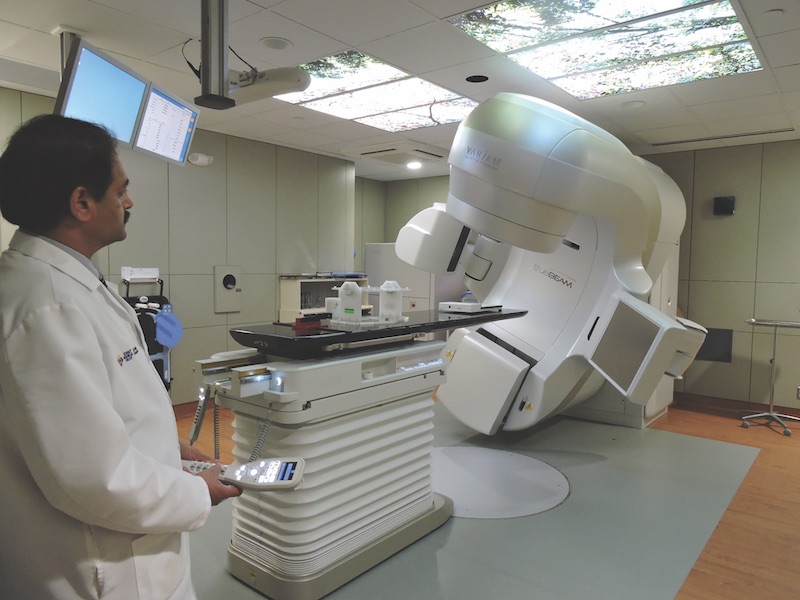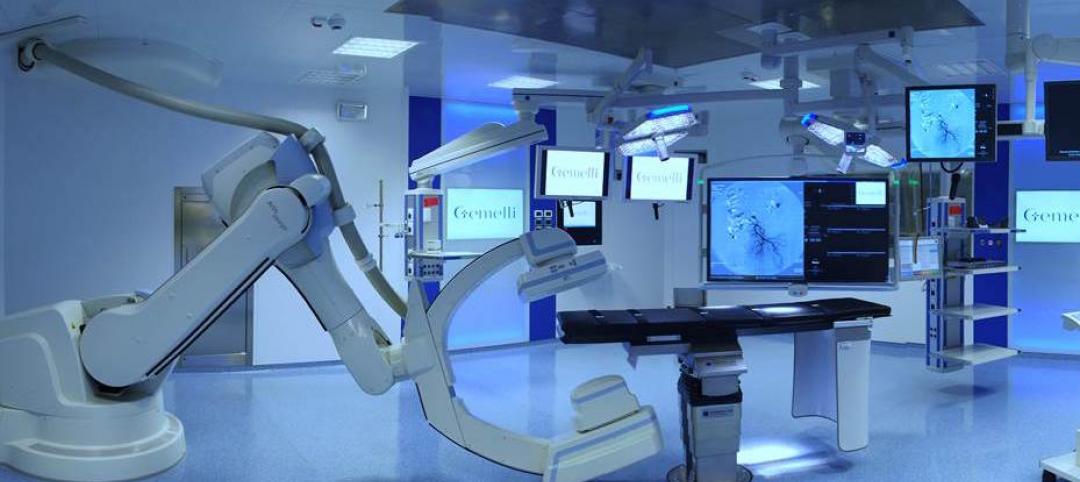On November 29, Summit Medical Group MD Anderson Cancer Center opened a 6,115-sf radiation oncology department within its campus in Berkeley Heights, N.J. This treatment center—half new construction, half renovation of a building that had been used for family services—is “important for Summit in terms of expanding its comprehensive treatment program,” says David Fernandez, Vice President of Oncology Services for Summit Health Management.
The building is also a “benchmark,” he says, in Summit’s broader relationship with Houston-based University of Texas MD Anderson Cancer Center, one of the largest cancer treatment networks in the country.
A significant trend in cancer care finds large healthcare systems branching out by affiliating with regional hospitals and medical centers to open jointly named satellite departments and clinics in suburban and even exurban markets.
“Healthcare systems are absolutely looking at cancer care as a business from an expansion standpoint, because they don’t want to lose their patient base” to a more conveniently located competitor, says John Alsentzer, Project Manager in the Nashville, Tenn., office of Smith Seckman Reid, which has been getting “quite a few RFPs for cancer centers” lately.
Satellites are driven by the needs of the outpatient community primarily, explains Andrew Quirk, Senior Vice President and National Director for Skanska USA in Nashville. “Even Memorial Sloan Kettering is making a huge effort to capture that marketplace.”
Quirk points, by way of example, to the 207,000-sf McKinley Outpatient Treatment facility, a $68 million Skanska project that opened last fall about a mile from H. Lee Moffitt Cancer Center’s campus in Tampa, Fla. “Moffitt saw the need to get out into the marketplace,” says Quirk. And by consolidating its outpatient services into one six-story building, Moffitt freed up space to expand its main hospital on the University of South Florida campus.
This outpatient center’s services include phlebotomy, transfusion, screening and diagnostic mammography, MRI, bone-density testing, surgery, a pharmacy, and genetic risk assessment.
Los Angeles-based Cedars-Sinai Hospital is improving a previously unoccupied new building in the L.A. suburb of Tarzana to a three-floor, 30,000-sf cancer center that, when it opens later this year, will include doctors offices, four pods with double-sided exam rooms, an infusion room with 30 chairs, a pharmacy, labs, and lounges.
Doss Mabe, a Partner with ZGF, the architect on this project, says Cedars-Sinai has several build-to-suit or tenant-improvement satellite cancer centers either opened or in the works around L.A. He describes these as the “front door” to the healthcare system’s cancer care.
“It’s a very different design proposition” from larger cancer centers, says Mabe. Patients often view a neighborhood facility as they would a spa. Satellites are also designed for quicker construction, as speed to market is an important competitive criterion, he says. Cedars-Sinai is also hedging its bets by leasing the Tarzana property for only 10 years.
E.W. Howell Construction was recently awarded the Southampton Hospital-Phillips Family Cancer Center, the first of its kind to be located on the east end of Long Island, N.Y. The two-story, 12,000-sf building is designed like a traditional barn that is commonly found in this market.
“Southampton wanted to bring this closer to its patients, so they won’t have to travel so far,” says Robert Timperio, Vice President and head of E.W. Howell’s healthcare division. The cancer center will include a LINAC and CT/simulation room, radiation oncology, four exam rooms on the first floor and three on the second, an infusion room with 14 chairs, conference rooms, and office space.
Timperio says Southampton Hospital is opening this satellite at a time when a number of Manhattan-based healthcare systems are coming to Long Island with outpatient centers.
The cancer center as a “franchise”
HDR did MD Anderson’s master plan, and Jon Crane, a Senior Vice President in the AE firm’s Atlanta office, reveals that the hospital’s growth strategy includes opening regional cancer centers domestically and internationally that range from 100,000 to 200,000 sf, and can handle a host of treatments.
Summit is currently collaborating with MD Anderson on a 130,000-sf outpatient facility under construction in Florham Park, N.J., that’s scheduled to open later this year. Its multidisciplinary menu of services will include radiation oncology, medical oncology, gynecological oncology, infusion, diagnostic imaging, mammography, and plastic surgery. Florham Park will also have a resource center that is accessible to patients and staff, and connects both to MD Anderson.
When asked why it chose to partner with MD Anderson, Summit’s Fernandez says the arrangement “is more like a franchise,” with specific design and programming criteria. He also says the partnership accentuates Summit’s commitment to support a consistently high level of service. “And, as we grow, they grow,” he says.
Molly Gabel, MD, Summit’s Medical Director of Radiology Services, was brought on board to help Summit set up its radiation oncology practice. She was instrumental in the design of the Berkeley Heights radiation oncology facility, which Summit submitted to MD Anderson for approval. The building took 18 months to complete.
Walking the new facility with a BD+C reporter, Gabel singles out little details, like the light-wood flooring and a closet in the hallway near the reception area, as examples of “softer” design touches that help put patients at ease.
The department is designed in a circle so that every patient passes a long nurses’ station before entering one of its three exam rooms or its treatment room. The department’s LINAC vault—one of the few in the country to combine a PET/CT scanner and High Dose Radiation machine in one room—is made somewhat less imposing by a backlit mural in the ceiling and an adjacent small outdoor garden area.
“Cancer care is a moving target, with discoveries being made all the time,” says Joseph Saphire, AIA, Partner, Saphire + Albarran Architecture, this project’s architect. “But the most important thing is still the patient experience and treating them with a great deal of respect, so they don’t feel like they’re being herded into a pen.”
The Berkeley Heights facility, with a 16-person staff, is currently handling 30-35 patients per day, with 60 being its capacity, says Fernandez.
Related Stories
Healthcare Facilities | Jul 20, 2016
Process mapping simplifies healthcare design
Charting procedures and highlighting improvement opportunities can lead to developing effective design strategy simulations. GS&P’s Ray Wong writes that process mapping adds value to a project and bolsters team and stakeholder collaboration.
Sponsored | Building Technology | Jul 11, 2016
3D scanning technology solves University of Iowa Children’s Hospital’s curved wall curveball
Gilbane Building Company utilized advanced 3D scanning technology as part of a virtual design and construction (VDC) solution to ensure quality control throughout the lifespan of the project
Healthcare Facilities | Jul 7, 2016
How to navigate the tedious regulatory approval process in healthcare construction
Compliance processes can be handled efficiently with a little bit of foresight. CBRE's Patrick Duke, Kyle Marden, and David Vollmer evaluate the regulations and permits that may be required and the process for incorporating approvals into projects.
Healthcare Facilities | Jul 1, 2016
AIA releases summary of the 2016 Design and Health Research Consortium
Consortium members discussed how architects, designers, and health professionals can best apply design and health research in their communities.
Healthcare Facilities | Jun 19, 2016
Rapid growth of retail health clinics presents new choices for consumers, payers, and providers
Service expansions help dealers boost clinics’ profitability.
Healthcare Facilities | Jun 10, 2016
Top 10 health technology hazards include some influenced by space design
ECRI Institute’s annual list includes operational and workflow issues.
Healthcare Facilities | May 30, 2016
CBRE finds that investors are still flocking to healthcare sector
Over the past year, healthcare accounted for nearly one-fifth of all new jobs in the U.S.
Big Data | May 27, 2016
Analytics alone won't save money for healthcare facility owners
Advanced technology provides insight into the actions necessary to cut costs, but it's the people, processes, and implementation that make a difference with analytics, writes CBRE's Paul Oswald.
Hospital Design Trends | May 19, 2016
CannonDesign releases new white paper on advancements in operating room environments
"Surgical Suites: Emerging Approaches to Planning and Design" offers solutions for collaboration and technology integration.
Healthcare Facilities | May 6, 2016
Infographic: The greening of healthcare
By adopting green building and sustainable practices, healthcare facilities can save $15 billion over 10 years. Skanska's infographic spells it all out.















